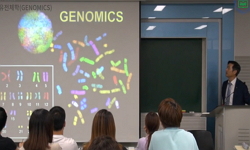Regulation of the peroxisome proliferator-activated receptor-γ (PPAR-γ) gene plays an important role in controlling the metabolism of lipids and inflammatory processes. Therefore, it can be associated with the pathogenesis of metabolic syndrome (Met...
http://chineseinput.net/에서 pinyin(병음)방식으로 중국어를 변환할 수 있습니다.
변환된 중국어를 복사하여 사용하시면 됩니다.
- 中文 을 입력하시려면 zhongwen을 입력하시고 space를누르시면됩니다.
- 北京 을 입력하시려면 beijing을 입력하시고 space를 누르시면 됩니다.

Peroxisome Proliferator-Activated Receptor-γ Gene Expression and Its Association with Oxidative Stress in Patients with Metabolic Syndrome
한글로보기https://www.riss.kr/link?id=A103564400
-
저자
Mehdi Hatami (Hamadan University of Medical Sciences) ; Massoud Saidijam (Hamadan University of Medical Sciences) ; Reza Yadegarzari (Hamadan University of Medical Sciences) ; Shiva Borzuei (Hamadan University of Medical Sciences) ; Alireza Soltanian (Hamadan University of Medical Sciences) ; Marzieh Safi Arian (Hamadan University of Medical Sciences) ; Mohammad Taghi Goodarzi (Hamadan University of Medical Sciences)

- 발행기관
- 학술지명
- 권호사항
-
발행연도
2016
-
작성언어
English
- 주제어
-
등재정보
KCI등재
-
자료형태
학술저널
-
수록면
201-206(6쪽)
-
KCI 피인용횟수
1
- 제공처
- 소장기관
-
0
상세조회 -
0
다운로드
부가정보
다국어 초록 (Multilingual Abstract)
Regulation of the peroxisome proliferator-activated receptor-γ (PPAR-γ) gene plays an important role in controlling the metabolism of lipids and inflammatory processes. Therefore, it can be associated with the pathogenesis of metabolic syndrome (MetS). The purpose of this study was to determine the expression of this gene in peripheral blood mononuclear cells (PBMC) in patients with metabolic syndrome. Using real-time polymerase chain reaction (PCR), mRNA expression of PPAR-γ was found in PBMC from 37 subjects with MetS and 30 healthy controls. Serum levels of glucose and lipid profiles were measured. The total antioxidant capacity (TAC) was measured using the ferric reducing ability of plasma (FRAP) test. Malondialdehyde (MDA) was determined using a fluorimetric method. Total oxidant status (TOS) in serum was assayed according to oxidation of ferric to ferrous in the presence of methyl orange. Super oxide dismutase (SOD) activity was measured using a Randox kit. Expression of PPAR-γ gene was significantly increased in patients with MetS compared to the control subjects (p=0.002). There was no difference in serum levels of TAC, MDA and SOD between the two study groups, but a significant difference was observed in the TOS (p=0.03). Serum levels of triglycerides and glucose were significantly higher in subjects with MetS. According to the results of our study, an increase in the expression of PPAR-γ in subjects with MetS indicated a possible role of PPAR-γ in the pathogenesis of this disease.
참고문헌 (Reference)
1 Weiss R, "What is metabolic syndrome, and why are children getting it?" 1281 : 123-140, 2013
2 Lu B, "Type II nuclear hormone receptors, coactivator, and target gene repression in adipose tissue in the acute-phase response" 47 : 2179-2190, 2006
3 Kim MS, "Tumor necrosis factor and interleukin 1 decrease RXRalpha, PPARalpha, PPARgamma, LXRalpha, and the coactivators SRC-1, PGC-1alpha, and PGC-1beta in liver cells" 56 : 267-279, 2007
4 Narala VR, "The role of nitrated fatty acids and peroxisome proliferator-activated receptor gamma in modulating inflammation" 23 : 283-287, 2014
5 Szanto A, "The many faces of PPARgamma: anti-inflammatory by any means?" 213 : 789-803, 2008
6 Nunn AV, "The integration of lipid-sensing and anti-inflammatory effects: how the PPARs play a role in metabolic balance" 5 : 1-, 2007
7 Tootoonchi AS, "The expression of interleukins 10 and leptin receptor in peripheral mononuclear cells from patients with metabolic syndrome" 2 : 10055-10062, 2012
8 Fujita K, "Systemic oxidative stress is associated with visceral fat accumulation and the metabolic syndrome" 70 : 1437-1442, 2006
9 Dong C, "Role of peroxisome proliferator-activated receptors gene polymorphisms in type 2 diabetes and metabolic syndrome" 6 : 654-661, 2015
10 Sharma AM, "Review: peroxisome proliferator-activated receptor gamma and adipose tissue--understanding obesity-related changes in regulation of lipid and glucose metabolism" 92 : 386-395, 2007
1 Weiss R, "What is metabolic syndrome, and why are children getting it?" 1281 : 123-140, 2013
2 Lu B, "Type II nuclear hormone receptors, coactivator, and target gene repression in adipose tissue in the acute-phase response" 47 : 2179-2190, 2006
3 Kim MS, "Tumor necrosis factor and interleukin 1 decrease RXRalpha, PPARalpha, PPARgamma, LXRalpha, and the coactivators SRC-1, PGC-1alpha, and PGC-1beta in liver cells" 56 : 267-279, 2007
4 Narala VR, "The role of nitrated fatty acids and peroxisome proliferator-activated receptor gamma in modulating inflammation" 23 : 283-287, 2014
5 Szanto A, "The many faces of PPARgamma: anti-inflammatory by any means?" 213 : 789-803, 2008
6 Nunn AV, "The integration of lipid-sensing and anti-inflammatory effects: how the PPARs play a role in metabolic balance" 5 : 1-, 2007
7 Tootoonchi AS, "The expression of interleukins 10 and leptin receptor in peripheral mononuclear cells from patients with metabolic syndrome" 2 : 10055-10062, 2012
8 Fujita K, "Systemic oxidative stress is associated with visceral fat accumulation and the metabolic syndrome" 70 : 1437-1442, 2006
9 Dong C, "Role of peroxisome proliferator-activated receptors gene polymorphisms in type 2 diabetes and metabolic syndrome" 6 : 654-661, 2015
10 Sharma AM, "Review: peroxisome proliferator-activated receptor gamma and adipose tissue--understanding obesity-related changes in regulation of lipid and glucose metabolism" 92 : 386-395, 2007
11 석한나, "Refocusing Peroxisome Proliferator Activated Receptor-α: A New Insight for Therapeutic Roles in Diabetes" 대한당뇨병학회 37 (37): 326-332, 2013
12 Klotz L, "Proinflammatory stimulation and pioglitazone treatment regulate peroxisome proliferator-activated receptor gamma levels in peripheral blood mononuclear cells from healthy controls and multiple sclerosis patients" 175 : 4948-4955, 2005
13 Grygiel-Górniak B, "Peroxisome proliferator-activated receptors and their ligands: nutritional and clinical implications--a review" 13 : 17-, 2014
14 Hwang J, "Peroxisome proliferator-activated receptor-gamma ligands regulate endothelial membrane superoxide production" 288 : C899-C905, 2005
15 Zingarelli B, "Peroxisome proliferator-activated receptor-gamma is a new therapeutic target in sepsis and inflammation" 23 : 393-399, 2005
16 Setoguchi K, "Peroxisome proliferator-activated receptor-gamma haploinsufficiency enhances B cell proliferative responses and exacerbates experimentally induced arthritis" 108 : 1667-1675, 2001
17 Stienstra R, "PPARs, Obesity, and Inflammation" 2007 : 95974-, 2007
18 Macias-Gonzalez M, "PPARgamma mRNA expression is reduced in peripheral blood mononuclear cells after fat overload in patients with metabolic syndrome" 138 : 903-907, 2008
19 Garcia-Fuentes E, "PPARgamma expression after a high-fat meal is associated with plasma superoxide dismutase activity in morbidly obese persons" 18 : 952-958, 2010
20 Medina-Gomez G, "PPAR gamma 2 prevents lipotoxicity by controlling adipose tissue expandability and peripheral lipid metabolism" 3 : e64-, 2007
21 Victor VM, "Oxidative stress and mitochondrial dysfunction in type 2 diabetes" 17 : 3947-3958, 2011
22 Del Ben M, "Moderate weight loss decreases oxidative stress and increases antioxidant status in patients with metabolic syndrome" 2012 : 960427-, 2012
23 Kassi E, "Metabolic syndrome:definitions and controversies" 9 : 48-, 2011
24 Leclercq IA, "Insulin resistance in hepatocytes and sinusoidal liver cells:mechanisms and consequences" 47 : 142-156, 2007
25 Furukawa S, "Increased oxidative stress in obesity and its impact on metabolic syndrome" 114 : 1752-1761, 2004
26 Alberti KG, "Harmonizing the metabolic syndrome: a joint interim statement of the International Diabetes Federation Task Force on Epidemiology and Prevention; National Heart, Lung, and Blood Institute; American Heart Association; World Heart Federation; International Atherosclerosis Society; and International Association for the Study of Obesity" 120 : 1640-1645, 2009
27 Benzie IF, "Ferric reducing/antioxidant power assay: direct measure of total antioxidant activity of biological fluids and modified version for simultaneous measurement of total antioxidant power and ascorbic acid concentration" 299 : 15-27, 1999
28 Saidijam M, "Expression of interleukins 7& 8 in peripheral blood mononuclear cells from patients with metabolic syndrome: a preliminary study" 140 : 238-243, 2014
29 Xu H, "Chronic inflammation in fat plays a crucial role in the development of obesity-related insulin resistance" 112 : 1821-1830, 2003
30 Tavoosi Z, "Cholesterol Transporters ABCA1and ABCG1 Gene Expression in Peripheral Blood Mononuclear Cells in Patients with Metabolic Syndrome" 2015 : 682904-, 2015
31 Winterbourn CC, "Brian M, Carrell RW. The estimation of red cell superoxide dismutase activity" 85 : 337-341, 1975
32 Ohkawa H, "Assay for lipid peroxides in animal tissues by thiobarbituric acid reaction" 95 : 351-358, 1979
33 Lirussi F, "Antioxidant supplements for non-alcoholic fatty liver disease and/or steatohepatitis" (1) : CD004996-, 2007
34 Livak KJ, "Analysis of relative gene expression data using real-time quantitative PCR and the 2(-Delta Delta C(T)) Method" 25 : 402-408, 2001
35 Hopps E, "A novel component of the metabolic syndrome: the oxidative stress" 20 : 72-77, 2010
36 Pfaffl MW, "A new mathematical model for relative quantification in real-time RT-PCR" 29 : e45-, 2001
37 Erel O, "A new automated colorimetric method for measuring total oxidant status" 38 : 1103-1111, 2005
동일학술지(권/호) 다른 논문
-
- 전남대학교 의과학연구소
- Kenichi Nakajima
- 2016
- KCI등재
-
- 전남대학교 의과학연구소
- 이태호
- 2016
- KCI등재
-
Circulating Tumor Cell and Cell-free Circulating Tumor DNA in Lung Cancer
- 전남대학교 의과학연구소
- Fariz Nurwidya
- 2016
- KCI등재
-
A Case of Acute Pyelonephritis in Bilateral Renal Malrotation
- 전남대학교 의과학연구소
- 김하연
- 2016
- KCI등재
분석정보
인용정보 인용지수 설명보기
학술지 이력
| 연월일 | 이력구분 | 이력상세 | 등재구분 |
|---|---|---|---|
| 2027 | 평가예정 | 재인증평가 신청대상 (재인증) | |
| 2021-01-01 | 평가 | 등재학술지 유지 (재인증) |  |
| 2018-01-01 | 평가 | 등재학술지 유지 (등재유지) |  |
| 2015-01-01 | 평가 | 등재학술지 선정 (계속평가) |  |
| 2013-01-01 | 평가 | 등재후보학술지 유지 (기타) |  |
| 2012-01-01 | 평가 | 등재후보 1차 FAIL (등재후보1차) |  |
| 2010-01-01 | 평가 | 등재후보학술지 선정 (신규평가) |  |
학술지 인용정보
| 기준연도 | WOS-KCI 통합IF(2년) | KCIF(2년) | KCIF(3년) |
|---|---|---|---|
| 2016 | 0.16 | 0.16 | 0.11 |
| KCIF(4년) | KCIF(5년) | 중심성지수(3년) | 즉시성지수 |
| 0.1 | 0.08 | 0.34 | 0.06 |




 KCI
KCI







